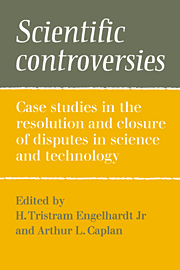 Scientific Controversies
Scientific Controversies Published online by Cambridge University Press: 03 February 2010
The Occupational Safety and Health Administration (OSHA) stands in the eye of the storm about government regulation. Mere mention of OSHA in many quarters triggers rancorous rhetoric, revealing underlying conflicts about the power relationships of labor and management, about social responsibility of corporations, about “internalizing” the costs of products and production, and about concepts of freedom in our society.
One of the more amusing political moments of 1980 was the Kissingerian negotiation at the Republican National Convention aimed at placing former President Ford on the ticket with Mr. Reagan. One wag, impressed with Kissinger's negotiating skills and with his chutzpah in agreeing with the television interviewers that Ford would be “co-President,” warned Reagan that by the time the areas of responsibility had been distributed, he – Reagan – might be left with “nothing but OSHA”! Dignified businessmen, upon joining a discussion about OSHA, are prone to begin talking about heights of toilet seats and spacing of rungs on ladders – as examples of the weighty matters that they think preoccupy OSHA inspectors. And the sagebrush conservatives who moved to Washington in 1981 love to describe the big poster of “The Cowboy after OSHA,” wearing goggles and helmet; a net surrounding his horse; and a box safely dangling beneath the horse's derrière as an “antipollution device.”
In the Closure Project meetings about occupational safety and health and about certain specific standards promulgated by OSHA, it is essential to recognize the serious conflicts in values and high emotion that set the context for any specific debates.
Employers with good safety records complain that OSHA cites them for violations that are irrelevant to good safety practices.
To save this book to your Kindle, first ensure [email protected] is added to your Approved Personal Document E-mail List under your Personal Document Settings on the Manage Your Content and Devices page of your Amazon account. Then enter the ‘name’ part of your Kindle email address below. Find out more about saving to your Kindle.
Note you can select to save to either the @free.kindle.com or @kindle.com variations. ‘@free.kindle.com’ emails are free but can only be saved to your device when it is connected to wi-fi. ‘@kindle.com’ emails can be delivered even when you are not connected to wi-fi, but note that service fees apply.
Find out more about the Kindle Personal Document Service.
To save content items to your account, please confirm that you agree to abide by our usage policies. If this is the first time you use this feature, you will be asked to authorise Cambridge Core to connect with your account. Find out more about saving content to Dropbox.
To save content items to your account, please confirm that you agree to abide by our usage policies. If this is the first time you use this feature, you will be asked to authorise Cambridge Core to connect with your account. Find out more about saving content to Google Drive.